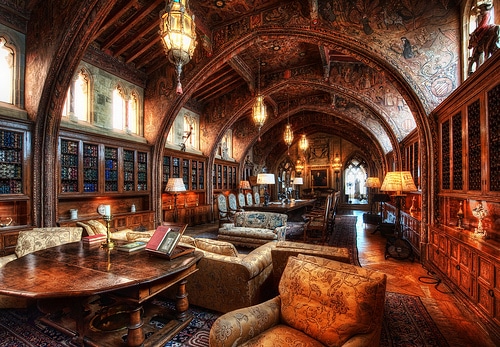
Just about two years ago, we wrote a post called 14 Famous Man Rooms, which offered a look at the rooms where over a dozen famous men wrote classic books, pondered big ideas, and tinkered with their inventions. Readers offered some really great additions in the comments, and we’ve come across more interesting, manly rooms in the interim, so we decided to put together a follow-up to that post. While the rooms in the former post ran the gamut from Frederick Douglass’ office to Frank Lloyd Wright’s drafting studio, this post focuses on libraries, writing rooms, and studies.
I don’t know about you, but visiting historical homes is one of my favorite things to do while on vacation. There’s something about being in the place where people lived and loved, the rooms where they paced anxiously, shed tears, and celebrated achievements, that really makes me feel connected to the past and to a man’s personal history in a way that fascinates and inspires me. If you can’t crisscross the globe this summer, come along with us for a tour through 15 rooms where famous men, both past and present, hatched and penned their influential words and ideas.
Rudyard Kipling’s Study
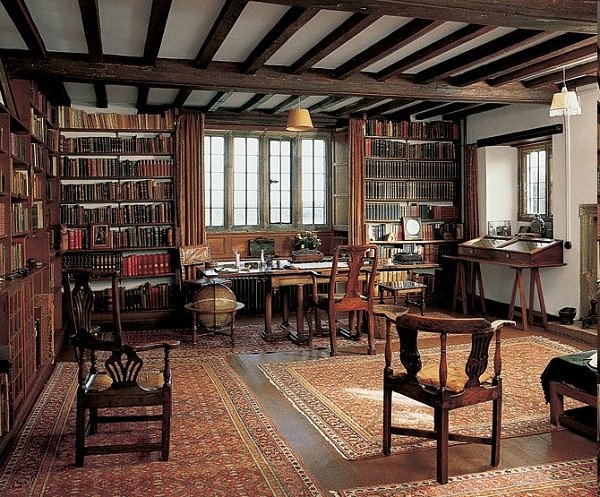
When Rudyard Kipling came upon the secluded, 17th century Bateman’s House in Sussex, he was immediately smitten. He wrote:
“We had seen an advertisement of her, and we reached her down an enlarged rabbit-hole of a lane. At very first sight the Committee of Ways and Means [Mrs Kipling and himself] said ‘That’s her! The only She! Make an honest woman of her–quick!’ We entered and felt her Spirit–her Feng Shui–to be good. We went through every room and found no shadow of ancient regrets, stifled miseries, nor any menace though the ‘new’ end of her was three hundred years old…”
The Feng Shui of Bateman’s was good to Kipling indeed. It was here in his study that he penned that manliest of manly poems–“If.”
William F. Buckley’s Study

If you were looking for William F. Buckley during his life, the first place to check was his study, which he converted from a garage. It was here, surrounded by mementos, books, and paintings (some of which he did himself), that he would toil on his columns and novels, and it was here that he was found dead when he passed away in 2008.
William Randolph Hearst’s Library & Study

Built in San Simeon, California by newspaper magnate William Randolph Hearst, Casa Grande, or Hearst Castle as it is now known, boasted 56 bedrooms, 61 bathrooms, 19 sitting rooms, 127 acres of gardens, indoor and outdoor swimming pools, a movie theater, tennis courts, an airfield, and the world’s largest private zoo. Hearst himself lived in the castle’s third floor Gothic Suite. The floor’s library (seen above) housed more than 4,000 books, along with 150 vases from ancient Greece.

Photo Sourcep
3,000 more books could be found in Hearst’s Gothic Study. The room served as a private library and office from which Hearst controlled his media empire and as an executive boardroom for discussing matters with his cohorts as well.
Be sure to also check out pics of the Hearst Castle’s billiards room, theater room, and indoor and outdoor pools — really unbelievable. This place is near the top of my to-visit list (Sagamore Hill — see below — currently holds the number one spot).
Roald Dahl’s Writing Hut
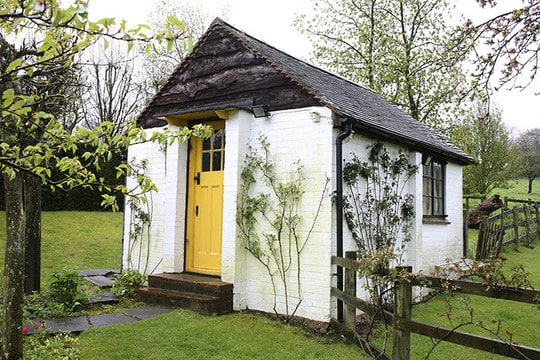
When Roald Dahl moved to Great Missenden in Buckinghamshire in 1965, he built a small writing hut (you can take a 3-D tour here) for himself. Dahl’s family has kept the hut much like it was when the author died, but even during his life it was a pretty dark, bare bones, ramshackle sort of place. No one could enter the hut but Dahl himself, and no one was allowed to clean it either; it reeked of tobacco and the floor was covered with pencil shavings and cigarette ash.
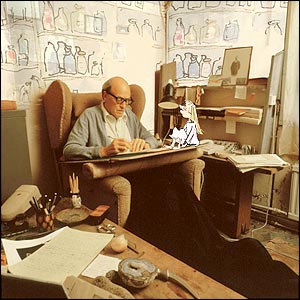
The solitude of his hut inspired Dahl’s creativity; he wrote all of his children’s stories from within its little walls. Here’s how Dahl described the power of the place:
“You become a different person, you are no longer an ordinary fellow who walks around and looks after his children and eats meals and does silly things, you go into a completely different world. I personally draw all the curtains in the room, so that I don’t see out the window and put on a little light which shines on my board. Everything else in your life disappears and you look at your bit of paper and get completely lost in what you’re doing. You do become another person for a moment. Time disappears completely. You may start at nine in the morning and the next time you look at your watch, when you’re getting hungry, it can be lunchtime. And you’ve absolutely no idea that three or fours hours have gone by.”
Sir Arthur Conan Doyle’s Study

Sir Arthur Conan Doyle lived in his Windlesham home on the outskirts of Crowborough in East Sussex for 23 years. When he died there in 1930, his request was to be buried in a garden next to a writing hut he had built on the property. But during his life, he actually preferred to write in the study on the first floor of his home. There he penned several of his famous Sherlock Holmes works, including The Poison Belt, in which he describes the view looking out from his study and across the Crowborough Common to distant Rotherfield.
Oh, and speaking of Mr. Holmes, he had a nice den too…
Sherlock Holmes’ Study
Sherlock Holmes is of course a fictional character, but that hasn’t stopped folks from recreating his office from the descriptions given by his creator.
There is one at the Sherlock Holmes Museum at 221B Baker Street:

And one at The Sherlock Holmes pub in Westminster:

Both look pretty cozy.
Jack London’s Study

Photo Source
When the stone mansion (“Wolf House”) Jack London was building on his Sonoma Valley ranch burned down in 1913, he built a tranquil, windowed annex onto the large “cottage” he and his wife Charmian had been living in for years. The study–in which he penned his final stories and novels–was adjacent to his “sleeping porch.” Now that’s a room you don’t hear much about these days, and one I would love to have, especially with this kind of view!

George Washington’s Study

George Washington’s study was built during the Revolutionary War as part of the expansion of his home. When the tired General returned to Mount Vernon in 1783, he was naturally called upon to entertain countless family, friends, politicians, and well-wishers. His study became the place where he could hide out and find solitude; no one was allowed in without an invitation. Here he could read one of his 884 books, oversee his estate, pen letters, and write in his diary. But he also used the room as a chamber for bathing and dressing. He would rise between 4-5 in the morning and make his way into the study via a private staircase that connected it to the master bedroom. In these two quiet hours before breakfast, he’d get ready for the day, review reports, and write letters. In the evening before bed, he’d be back in the study to discuss issues with his secretary or do some more reading before bed at 9 o’clock.
Neil Gaiman’s Writing Gazebo

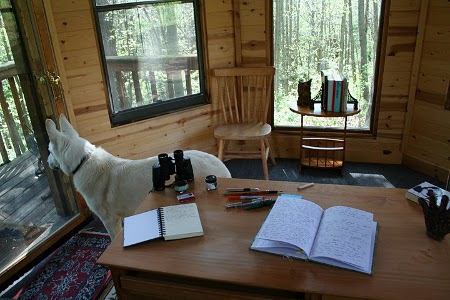
Here’s what contemporary author Neil Gaiman said about his enviable, Mark Twain-esquewriting gazebo in the book Shedworking:
“I had the gazebo built about 15 years ago, and go through phases of using it, and then I’ll abandon it for 5 years, then rediscover it with delight. I love walking to the bottom of the garden, and settling down to write.Nothing ever happens down there. I can look out of the window and some wildlife will occasionally look back, but mostly it’s just trees, and they are only so interesting for so long, so I get back to writing, very happily.There are heaters down there, because it gets cold here in winter, and blankets on the chairs, ditto, and I have to try and remember not to leave bottles of ink on the table as they freeze. It’s just out of reach of the house Wifi, too, which is a good thing.”
Winston Churchill’s Study

What is often overlooked about Winston Churchill is that his primary income — his only income when he was out of office — came from his writing. And he did the bulk of that writing, 50 books and hundreds of articles, from his study at Chartwell Manor, his main residence for forty years. With 20 foot ceilings crisscrossed with 11th century rafters, books spilling out from the bookcases and piled against every wall, paintings of Napoleon, Lord Nelson, and his wife, and a magnificent view of Chartwell’s picturesque gardens and lakes (which Churchill built himself), the study was the heart of the home, Churchill’s sanctuary, and the place he spent much of his time–often in the wee hours of the morning.

After Churchill’s favorite part of the day — a sumptuous 8:00 dinner, along with stimulating conversation and plenty of cigars, brandy, and port — Churchill would change out of his tuxedo and into a bathrobe and slippers before walking through the Tudor doorway of his study (which he called “the factory”) at about 10:30 or 11 pm. There he would pore over the galley proofs laid stacked on top of his upright table, sit and write on his mahogany desk, and dictate to his two secretaries who lived in residence on the property. After dictating 3-4,000 words, Churchill would dismiss his secretaries at about 2 or 3 in the morning and hit the sack.
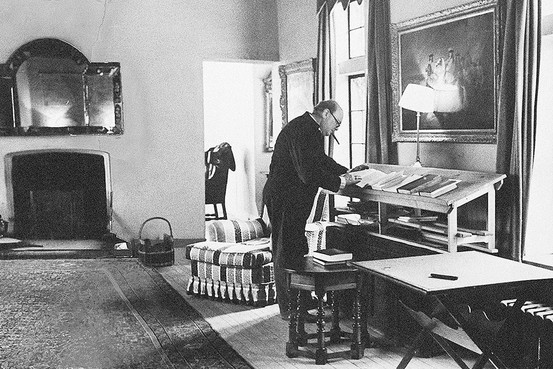

Norman Mailer’s Apartment


Norman Mailer’s apartment did not really have a dedicated library; rather, the whole apartment was a library of sorts, with bookshelves sitting against many of the walls and volumes stacked into various nooks and crannies. Seen here as it looked a few years after his death, and having been, according to his son “slightly feminized,” the Mailer-designed apartment has a nautical theme, complete with galley-like rooms and gangplank-esque walkways that lead to neat loft areas. Mailer designed the unique apartment partly to conquer his vertigo, and in his younger years, he hung a hammock between the rafters, a trapeze from the ceilings, and rope ladders from the different levels.

Theodore Roosevelt’s Library & Gun Room
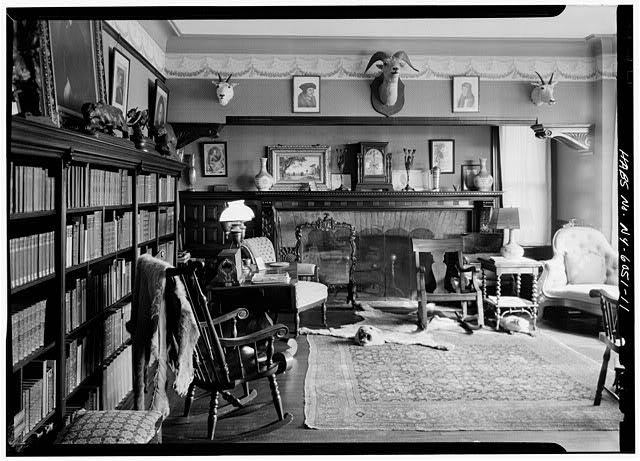
After Theodore Roosevelt’s Dakota cattle business failed, he came back East and built a home in Oyster Bay, NY. He called his estate Sagamore Hill, and he lived there until he died (with a stint in the White House, of course). It was where Roosevelt would go to relax, romp in the woods, and revitalize his man spirit. In addition to having a really manly trophy room, the home also included a nice library where TR would spend much of his time. Situated on the first floor of the home, it was decorated with animal skins from Roosevelt’s hunts, along with portraits of TR’s heroes.
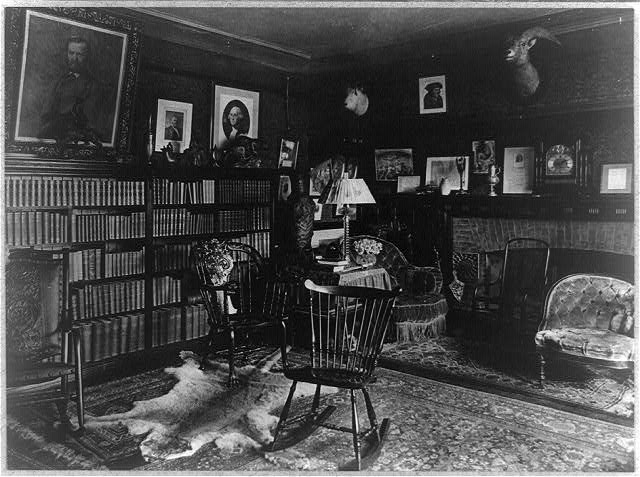
While he was president, Roosevelt would sometimes turn Sagamore Hill into the “Summer White House,” meeting with politicians and dignitaries in the library while Secret Service agents were stationed at the doors.
The library had also served as Roosevelt’s study before he married his second wife Edith, but because it had become a social center in the house and a place for entertaining guests, he and Edith decided to turn a room on the third floor into his “sanctum,” a hide out where he could write undisturbed (although his children could still often persuade him to take a break). Originally known as “the den,” Theodore Jr. imparted its lasting nickname, the “Gun Room,” so called because it displayed TR’s and his son’s hunting arms, which, sadly, you cannot see in the only photo I have been able to find of the room:

Jay Walker’s Library
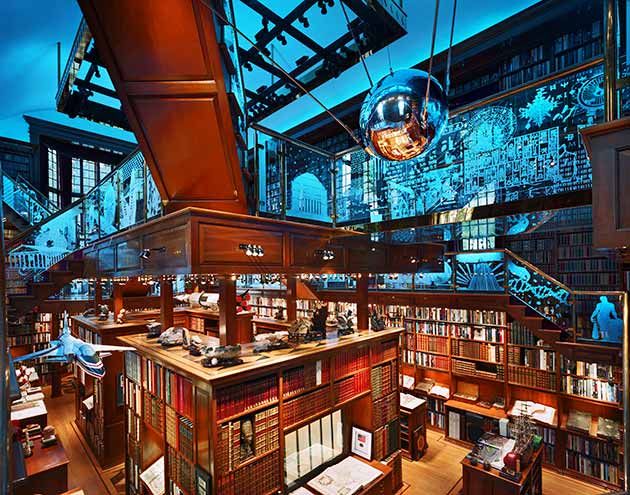
If William Randolph Hearst had lived in the 21rst century and been a lot geekier, this is what his library might have looked like. Created by the founder of Priceline.com, Jay Walker, to be a tribute to the human imagination, the 3,600 square foot library consists of three eye-popping levels, which were inspired by M.C. Escher’s famous sketches of floating stairs. The platforms are connected by glass-paneled bridges that allow you to see the first floor of the library as you stand on top of it. The railings are also made of glass, etched and illuminated with images depicting the discovery of great inventions and ideas. The library houses thousands of eclectic and rare books and artifacts, including one of seven surviving Sputniks, books bound in rubies and diamonds, fossilized dinosaur eggs, and the napkin upon which FDR scribbled his plan for winning WWII.

The fascinating details and images of Walker’s library are too numerous to recount here, so I recommend checking out the articles here and here to learn more about it, and to get a better look, you can take a virtual tour in this video.
Darren Bush’s Shack
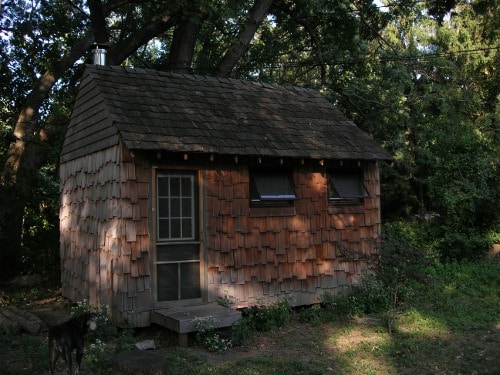
Okay, so Darren Bush isn’t famous in the traditional sense, but he’s famous around here as one of our contributing writers. I wanted to include the shack he built for himself, to give you some inspiration on what can be attainable even for the average Joe. Darren’s shack was inspired by the writing hut of author and conservationist Sigurd Olson, and he uses it for writing and getting away from it all. Here’s Darren describing how he built it with a friend:
“It took me about a year, start to finish, but it sat idle for six months while I scrounged parts (the windows, wood stove, chimney and some of the other stuff was recycled). Once we had the stuff, it was up and sheathed in two days. The roof took another few weeks working on it after work, as well as the siding.The inside was done over a few months, just an hour or so when I could get away. The furniture and stuff was scrounged, except for the table which was our old kitchen table refinished. The chair was picked off the curb and reupholstered, the rocker was a snowshoe kit I built, and of course the stove tools were custom made [Darren is into blacksmithing].”
I’ve been trying to convince Darren to write some posts on just how he built his shack — I’m sure some encouraging comments from readers could help sway him!
Here are some pics of the inside of the shack:

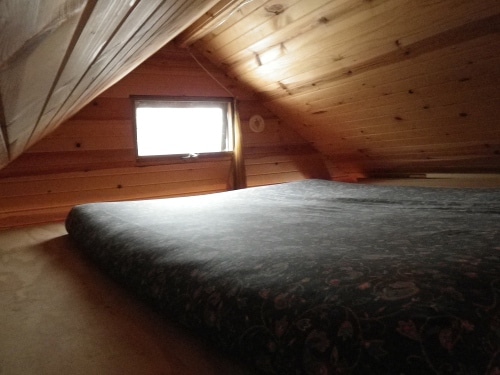
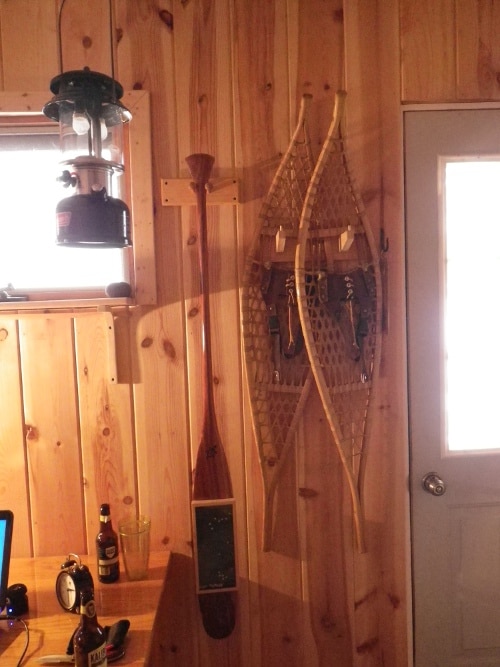
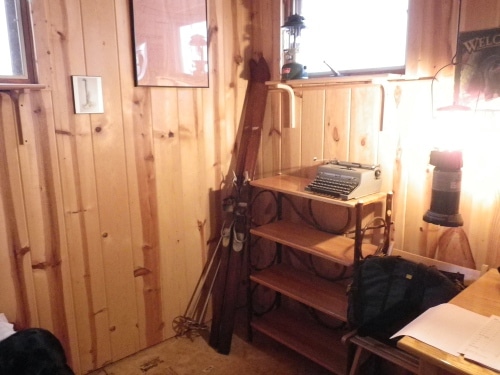
No comments:
Post a Comment